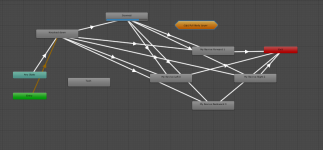Link from where I came from before this. https://opsive.com/forum/index.php?...-knocked-down-to-laying-down.4185/#post-21015
Trying to implement within
Ability - Downed : the only way to exit downed is by MyRevive(ButtonPress), pressing Specific attack abilities, or by being attacked (which results in KnockedDown -> Downed)
What route would you recommend to transition between Downed(laying on the ground) to MyRevive(Standing up)?
My animator keeps getting stuck which I'm sure is because I haven't scripted the proper rules into Downed and also haven't properly come up with a proper transition built into one of the abilities. One of the issues I am facing is within MyRevive.cs CanStartAbility I turn off the Downed ability, then that animator gets stuck. I keep trying new things and I can't quite figure out a fix.
Trying to implement within
Ability - Downed : the only way to exit downed is by MyRevive(ButtonPress), pressing Specific attack abilities, or by being attacked (which results in KnockedDown -> Downed)
What route would you recommend to transition between Downed(laying on the ground) to MyRevive(Standing up)?
My animator keeps getting stuck which I'm sure is because I haven't scripted the proper rules into Downed and also haven't properly come up with a proper transition built into one of the abilities. One of the issues I am facing is within MyRevive.cs CanStartAbility I turn off the Downed ability, then that animator gets stuck. I keep trying new things and I can't quite figure out a fix.
